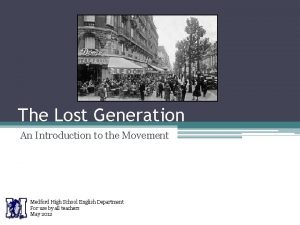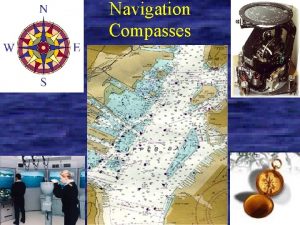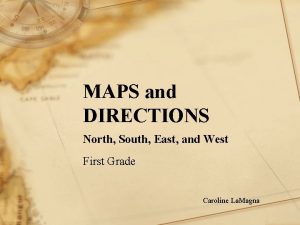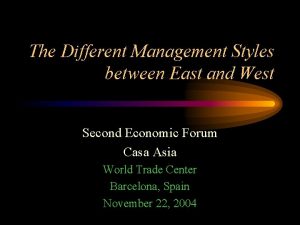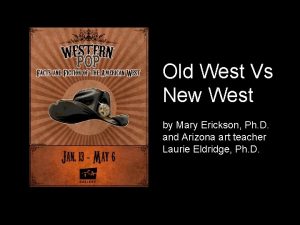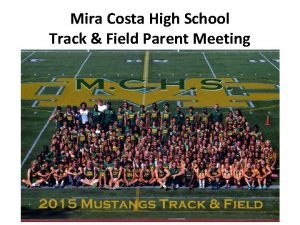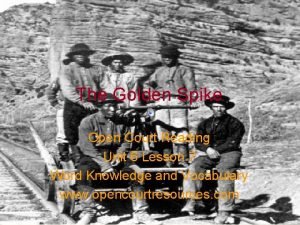The Golden Spike Connecting East and West History








































































- Slides: 72

The Golden Spike – Connecting East and West History of the First Transcontinental Railroad OLLI Class 2 of 3 Engineers/surveyors, Chinese, Irish, Indians, Civil War Vets, Mormans, Congress Kenton Colvin Mon Valley Railroad Historical Society 128 Pleasant Street, Morgantown, WV mvrrc. org

Course Schedule • July 24 – Importance to United States, Political Interests, History Overview, Central Pacific RR and the Union Pacific RR. • July 31 – People Groups: Engineers and surveyors, Chinese, Irish, Indians, Civil War Vets, Mormons, Congress, and other people groups. • August 7 – Hell on Wheels, Major Building Problems, Corruption, Discord Between Railroad Companies, Meeting at Promontory, Utah.

Engineers and Surveyors • Most engineers and surveyors who figured out how and where to build the railroad on the U. P. were engineering college and/or U. S. Military Academy trained Union Army veterans who had learned their railroad trade keeping the trains running and tracks maintained during the Civil War. • U. S. Military Railroad (USMRR) which was established by the U. S War Department as a separate agency to operate and repair any rail lines needed by the Union army or seized by the government from the Confederates. • They controlled over 2, 000 miles by the end of the war. • Extensive experience building truss bridges was acquired as many bridges had to be built or rebuilt during the war.

Typical Wooden Bridge 650 -foot long and 150 -foot above Dale Creek

Dale Creek Bridge • Just east of Laramie, Wyoming, sat very near the highest elevation along the Union Pacific line— 8, 247 -foot Sherman Pass. The bridge towering more than 15 stories above the stony bed of Dale Creek, was the highest bridge between Omaha and Sacramento. • Construction began in December 1867, and the first train crossed on April 23 the following year. • Considered one of the most dangerous bridges on the RR – trains had to creep across 720 -foot-long structure at no more than 4 mph miles per hour. Problem not engineering errors but prevailing strong winds near the summit that caused the structure to sway noticeably, and could tumble even boxcars into the rocky chasm below.

Wooden Bridge

Building the Railroad • Kits and techniques for rapidly building new bridges or repairing old bridges were developed by the remarkable U. S. Military Academy trained engineer Herman Haupt who headed the USMC during Civil war. • Nearly all of the Union and Confederate armies were supported and transported by extensive rail networks which had to be built up, expanded, protected and repaired as the armies advanced and retreated. • Most key workers and supervisors were trained by previous on-the-job training and knew what needed to be done and how to direct workers to get it done.

Union Pacific Irish Workers • Most semi-skilled workers on U. P. were recruited from discharged Union and Confederate Army veterans who were emigrant Irishmen escaping poverty and The Great Potato Famine. • Irish did not suffer from same kind of racial discrimination as the Chinese did on the Central Pacific. • Paid relatively little for hard work in dangerous territory. • Common construction role was track laying. • Killed by Native American war parties, who attacked laborers and construction crews.

Union Pacific Irish Workers

Mormons – Brigham Young • Brigham Young (1801 -1877) was an American religious leader, politician, and settler. • He was the second president of The Church of Jesus Christ of Latter-day Saints from 1847 until his death in 1877. • He founded Salt Lake City and he served as the first governor of the Utah Territory. • 1863: He invested $5, 000 in the Union Pacific Railroad. Young believed that the railroad would bring new LDS Church members and much-needed cash to the territory.

Mormons – Brigham Young • Asked congress to bring railroad through Salt Lake City. • Rallied the Mormans to work for railroad at lower wages that were being paid at the time. • He guaranteed the workers pay with his own finances. • His concerns: – Did not want the people building the railroad to come to Utah – Mormans experiencing locust plague for 3 years and farmers did not have any work. – Used the barter system for economy.

Brigham Young

Mormons • 1869: Latter-day Saints made up 98 percent of Utah’s total population. • The Mormons signed a contract with U. P. for $2, 000 to supply 4, 000 workers to lay 120 miles of track near the Salt Lake Area through Echo and Weber Canyons in Utah. • They supplied about a 1, 000 workers to the Central Pacific for railroad work. • Many left the work for non payment. Most men never got paid by the railroad.

Mormans Working

Central Pacific • Hired engineers and surveyors who had extensive experience and training building railroads and knew what needed to be done and how to supervise others. Some were Canadian and British trained. • Faced a semi-skilled labor shortage - relied on some black employees escaping the slavery and turmoil of Civil War. • Supervisory, engineering and skilled jobs were done with experienced white workers including a lot of Irishmen. • A large majority of the white laboring class on the Pacific Coast found more profitable and congenial employment in mining and agricultural pursuits, than in railroad work.

Central Pacific - Chinese • 1865 – 50, 000 Chinese in California. 27 -1 Male to Female. • 1865 hired first Chinese (approximately $28/mo. ) to do very dangerous work of blasting and laying ties over Sierras. • By the end of 1865 – 7, 000 workers with a little less than 2, 000 whites. Experienced some persecution. • Lived in simple dwellings and cooked own meals, often consisting of fish, dried oysters and fruit, mushrooms and seaweed. At several dining camps you could see hundreds sitting on the ground, eating soft boiled rice with chopsticks as fast as others could with soup-ladles.

Chinese Workers

Chinese Workers

Golden Spike Ceremony (No Chinese)

Central Pacific • Most black and white workers - $30. 00/mo. and food and lodging. Higher skilled and supervisory jobs paid more. • Most Chinese were initially paid $31. 00/month and provided lodging. They bought and cooked their own food—as they desired. 1867 this was raised to $35. 00/month after a strike. • Chinese, despite their small stature and total lack of experience with RR work, handled most of heavy manual labor needed to get over and through the Sierra Nevada mountains and across the Nevada and Utah deserts. • Only a very limited amount of work could be done by animals, simple machines or black powder.

Where did the Chinese workers come from? • Recruited by labor contractors mostly from Guangdong (Canton) province, especially Siyi (Sze Yap, meaning four counties: Taishan, Kaiping, Xinhui and Enping). • Suffered from extreme poverty and civil unrest, and they were close to Hong Kong as a point of departure. Desperate for work, workers boarded ships for CA and other parts to support their families. • To conquer many sheer embankments, workers used techniques learned in China. They were lowered by ropes from the top of cliffs in makeshift baskets, and while suspended, they chipped away at the granite, drilled holes, and planted explosives that were used to blast tunnels. After fuse was lit, they were yanked up as fast as possible. • Many workers risked their lives and perished in the harsh winters and dangerous conditions. Most came from southern China and never saw snow.

Chinese Workers • July 1865, Chinese workforce was nearly 4, 000. • In February 1867, approximately 8, 000 Chinese were working on the construction of tunnels and 3000 were laying track, representing ninety % of the workforce. • Historians estimate that at any one time as many as 10, 000 to 15, 000 Chinese were working on the RR. No documents. • Most Chinese did not work for the entire duration of construction and others would take their place, particularly because the work was so difficult and dangerous. The total number of Chinese may be even higher.

What were the Chinese workers paid in comparison to workers of European descent? (2/3) • Chinese workers were initially paid $24 to $31 per month, although rates would vary depending on how skilled or dangerous the work. • EX: those working in the tunnels were paid an extra $1 per month. Their pay eventually rose to $35 per day, which was roughly the same as for workers of European descent. • Chinese workers worked longer hours and had to pay for their own lodging and food and even for their tools. • C. P. and U. P. provided white workers accommodations, food, and tools without additional cost.

What were the hardest and most hazardous parts of the railroad route for them to build? Bloomer Cut • Early 1864 workers began blasting and digging through steep terrain on the Bloomer Ranch near Auburn, CA, to create a level grade for tracks. Completed in March 1865. • Bloomer Cut, 38 miles from Sacramento, was 800 feet long and 63 feet high, and workers dug a trough through naturally cemented gravel and hard clay with picks, shovels and black powder. • 1 st major engineering challenge and it was dangerous work.

Bloomer Cut

Bloomer Cut

Tunnels • Fall 1865: Chinese workers began building 15 tunnels, most of them at high elevations through Sierra Nevada for a total of 6, 213 feet. • Most difficult tunnel was No. 6, the Summit Tunnel, cut through solid granite, 1, 695 feet long and 124 feet below the surface. • Very slow progress. Many kegs of black powder used each day, but to little effect. Nitroglycerine mixed on site by a chemist was too unstable - many accidents (abandoned). • Workers built a vertical shaft halfway between the two tunnel openings, and in shifts around the clock they dug four faces simultaneously, from both exterior sides and from inside out.

Nitroglycerine

Summit Tunnel • Work continued through two of the worst winters on record. Snow from fierce blizzards often blocked tunnel entrances, and avalanches would sweep away camps of Chinese workers, carrying many to their death. • The Summit Tunnel was completed, graded and track laid on November 30, 1867. • Because of the severe winter storms, the Central Pacific built 37 miles of snow sheds to cover the tracks in 1868 and 1869. The snow sheds were nicknamed the “longest barn in the world. ”

Tunnel Blasting

How many Chinese workers died building the transcontinental railroad? • C. P. did not keep records of the deaths of any workers. • Small estimates are gained from engineering reports, newspaper articles and other sources Chinese were killed: result of snow slides, landslides, explosions, falls and other accidents. • Chinese practice: bury the dead temporarily and at a later date collect the remains in a box in a ritual fashion. Then ship back to China to be reburied in worker’s home village. • June 30, 1870: newspaper article “Bones in Transit” in Sacramento Reporter reported that “about 20, 000 pounds of bones” dug up from shallow graves were taken by train for return to China (1, 200 bodies).

What happened in the 1867 strike? • June 25, 1867 Chinese workers went on strike. • Five thousand workers grading along the eastern slope of the Sierra between Cisco and Strong’s Canyon and digging tunnels put their tools down and returned to their camps. • First hired in 1864 they earned $25 per day, but then wages were raised again. In Spring 1867 Charles Crocker raised their wages from $31 to $35 per month; but the workers demanded $40 per month, reduced workdays from eleven to ten hours, and shorter shifts digging in the cramped, dangerous tunnels (supposed 8 hours).

1867 Strike • Crocker: “If there had been that number of white laborers [on strike] … it would have been impossible to control them. But this strike of the Chinese was just like Sunday all along the work. These men stayed in their camps. That is, they would come out and walk around, but not a word was said. No violence was perpetrated along the whole line. ” • Despite their non-violent tactic, the strike posed a threat to Crocker and C. P. “The truth is they are getting smart, ” Charles’ brother E. B. Crocker wrote. • Charles Crocker cut off food and other supplies. After eight days, Crocker confronted the starving workers, along with their Sherriff and a contingent of deputized white men, insisting that he would make no concessions and threatened violence. • Facing starvation and coercion, the workers ended the strike. Crocker became convinced that strike was a plot by U. P.

Were the workers literate, and did they send letters back to China? • Since the workers came from the agricultural region of Guangdong, it is generally believed that most were illiterate farmers. • However, by the commonly accepted American definition of literacy – being able to read and write – a number may, in fact, have been literate. At least some of the workers were educated; certainly, the headmen and agents for labor contractors could speak English and tally accounts, and at least one labor contractor had apparently passed the lower level of the mandarin civil service exams. • So far, though, no letter or document of any sort written by one of the Central Pacific workers has been found.

Why do we not know many of their names? • Chinese naming practices required three names. First was the family name for a male, followed by a middle name that indicates the person’s village and generation, and lastly the given name, often with symbolic or aspirational meaning. • English speakers found Chinese names very difficult to understand, and they are listed in payroll records and newspaper articles in simplified forms or what could be described as nicknames, such as Ah Fong, Ah Chung and Ah Lim, with “Ah” serving as a designation less formal than “Mister. ” • Consequently, we have very few actual names, making it very difficult to track down the actual workers.

What kind of food did they eat? • Chinese food: rice, dried vegetables, dried oysters, dried abalone fish, and some pork and poultry. Much of the food came from California sources, such as fresh vegetables. • They also drank tea and hot water with occasional wine and opium. The Irish or white workers were fed mainly meat and potatoes along with whiskey. Chinese diet and especially the use of boiled water reduced the outbreak of dysentery and other diseases. • As they work moved through Nevada, the C. P. had two train cars labeled “China Store, ” from which goods could be purchased. • Chinese cooks were paid more than unskilled workers. Chinese in their contracts insisted a Chinese physician be in vicinity.

Chinese Workers – Important to Building RR • After RR finished, some went back to China; others worked in agriculture, mining, building levees along the rivers or went to various Chinatowns in CA, and small towns in Sierras to enter domestic service or work in manufacturing to produce cigars, etc. • Some continued to work for Central Pacific upgrading construction or work for other railroads. • Class: quiet, peaceable, patient, industrious and economical—ready and apt to learn all different kinds of work required in railroad building, they soon become as efficient as white laborers. • Very prudent and economical, contented with less wages. Organized into societies for mutual aid and assistance. These societies, (numbers of thousands), led by shrewd, intelligent business men, who promptly advised their subordinates where best employment was available.

Plains Indians • 350, 000 Indians with several tribes: • Two broad classifications which overlap to some degree. • The first group became a fully nomadic horse culture during the 18 th and 19 th centuries, following the vast herds of buffalo, although some tribes occasionally engaged in agriculture. These include the following tribes: Blackfoot, Arapaho, Assinboine, Comanche, Crow, Gros Ventre, Kiowa Lakota, Lipan, Plains Apache Plains Cree, Plains Ojibwe, Sarsi, Nakoda, Tonkawa

Plains Indians • The second group of Plains Indians were semisedentary, and, in addition to hunting buffalo, they lived in villages, raised crops, and actively traded with other tribes. These include the following: Aikara, Hidatsa, Iowa, Kaw (or Kansa), Kitsai, Mandan, Missouria, Omaha, Otoe, Pawnee, Ponca, Quapaw, Wichita, Santee Dakota, Yantonai, and the Yankton Dakota. • Both groups included people indigenous to the region, as well, as those who were pushed west by population pressure linked to the ever-westward expansion of white culture.

Plains Indians

Plains Indians • As white explorers and settlers entered Western territory, they disrupted a centuries-old culture of the Plains Indians. • 1860 s, Indians had signed away rights to much of their land in treaties. • They never imagined that a disruptive and massive system (railroad) would be constructed through their traditional hunting grounds. It altered forever the landscape and causing disappearance of once-reliable wild game. • The railroad was single biggest contributor to bison loss. Particularly traumatic to the tribes who depended on it for everything from meat for food to skins and fur for clothing, and more. (52)

Massacre at Sand Creek • Autumn 1864, (Civil War) Cheyenne Indians made winter quarters on Sand Creek in Colorado Territory. Invited (Army). • Fort Lyon 40 miles away - cavalry regiment under Colonel John Chivington. Seeking action, he led his soldiers under cover of night to Sand Creek November 29. Infamous order, "Kill and scalp all, big and little; nits make lice. “ • Soldiers swept down on the camp, surrounding unarmed natives and chasing away their ponies to prevent escape. • Chief Black Kettle waved a white flag to no avail. Over 150 Cheyenne were murdered, most women and children. Indiscriminate slaughter prevailed with mutilating the corpses.

Chief Black Kettle – Southern Cheyenne

Retribution at Julesburg • Retribution fell 39 days later upon the frontier town of Julesburg, Colorado. • 1, 000 Sioux, Arapaho, and Northern Cheyenne -- survivors of Sand Creek among them -- overran the town, killing civilians and soldiers and distributing their body parts across the countryside. • They continued through Platte Valley, destroying stage stations and telegraph wires, effectively halting transcontinental communication. • Later, the party returned to Julesburg and burned it to the ground.

Armed Response • General Grenville Dodge led campaign against the Plains Indians following Julesburg, effectively dispersing war parties northward to Powder River Valley. • Dodge sent General Patrick Edward Connor after them with troops and scouts from one tribe friendly to whites, the Pawnees. • Connor and his men missed the raiders but attacked a peaceful settlement of unsuspecting Arapaho on the Tongue River, killing almost 200.

The "Menace" • Union Pacific cut its way westward across the Platte Valley in 1865, its workers grew fearful of "the Indian menace. “ • Cheyenne, Sioux, and Arapaho maintained a presence in their prime hunting land. Decades of mass immigration by settlers already destroyed countryside for buffalo herds, forcing tribes to search for food. • Tribal leaders usually ordered warriors to stay away from RR. Young men could not always be controlled. • Periodic sightings of Indians, skirmishes, and livestock raids persuaded chief engineer Dodge that they needed serious protecting. He repeatedly requested troops of William Sherman who declined, convinced that the Indians posed no real threat to the project.

Buffalo • 30 to 60 million buffalo roamed the plains. Massive and majestic herds, rumbling by hundreds of thousands, creating the sound - nickname “Thunder of the Plains. ” • The bison’s lifespan of 25 years, rapid reproduction and resiliency in their environment enabled them to flourish, as Indians were careful not to overhunt. Indians knew of 52 things to make out of a buffalo. It took 12 -14 hides to make one Teepee. • Even men like William “Buffalo Bill” Cody, who was hired by Kansas Pacific RR to hunt bison to feed thousands of laborers for years, could not make a dent in their population. • In mid-century, trappers who had depleted the beaver populations began trading in buffalo robes and tongues; an estimated 200, 000 buffalo were killed annually. The completion of the Transcontinental Railroad accelerated the decimation of the species.

Buffalo

Buffalo Stopping Trains

Pile of Bison Bones 1870

Slaughter on Bozeman Trail • 1866 event changed Sherman's attitude and put fear into the hearts of railroad workers, although it occurred away from their line. • Plains Indians watched as Platte Valley turned into white America's highway. They were incensed by army fortification of the Bozeman Trail through the Powder River Valley (most sacred and fertile hunting ground). • December 21: decoys attacked a wood train outside Fort Philip Kearny. A garrison led by arrogant Captain William J. Fetterman, (once boasted he could lick the entire Sioux tribe with just 80 men), rushed from the fort to support the train.

Slaughter on the Bozeman Trail • A superior officer told Fetterman 3 times not to engage the Indians. He ignored orders. Indian decoys led them into a waiting mass of Cheyenne, Miniconjous, and Red Cloud’s Oglala Sioux. Not a single soldier survived. • "We must act with vindictive earnestness against the Sioux, " Sherman seethed, "even to their extermination, men, women, children. “ • For the immediate future, however, the army did nothing. • Westward progress would suffice to force Native Americans from the Plains.

Incidents Along the Railroad • The railroad received its share of harassment. • Livestock was continuously rustled by tribal raiders, who also boldly shot up work crews and terrorized isolated station towns. • Particularly vulnerable were route surveyors, who struck out on their own ahead of the work crews -- and sometimes paid for it with their lives. • Native Americans sabotaged the iron rails themselves a few times.

Incidents Along the Railroad • In August 1867 a Cheyenne raiding party decided they would attempt to derail a train. They tied a stick across the rails and succeeded in overturning a handcar, killing its crew of repairmen, with the exception of a man named William Thompson. He was shot and scalped, but lived to tell about it as he traveled back to Omaha with his scalp in a pail of water by his side. • In 1868 a group of Sioux created a more intense blockade, upturning both rails and piling wooden ties in between them, then tying the whole thing together with telegraph wire. The resulting wreck killed two crewmen, one of who was crushed beneath the train's boiler.

William Thompson • 1867: Englishman sent to Lexington, Nebraska by U. P. to repair a telegraph line. • The train he was on was attacked by Cheyenne and Thompson was shot in the shoulder and then scalped. The others were killed but he survived. • Thompson’s scalp fell, abandoned, and he was able to retrieve it after the Indians had departed. • Returning to Omaha he tasked Dr. Richard Moore to reattach it. • Doctor failed to reattach the scalp, but Thompson kept it, and he returned to England where he displayed the scalp for money.

William Thompson

William Thompson – Scalp Today

“Cheyenne Indians tearing up the tracks of the Union Pacific R. R. ”




One Welcoming Tribe • Pawnee Indians had the greatest presence on the RR. • Friendly to American government and bitter enemies of the Sioux, the tribe welcomed the Union Pacific to their lands. • RR offered Pawnee people free passage on its work trains. In exchange, they staged mock raids and battles for visiting dignitaries at Union Pacific executive Durant’s lavish 100 th Meridian Excursion party. • Under army Major Frank North, a uniformed battalion of 800 Pawnee men patrolled the Union Pacific to protect crews and livestock from Sioux raiders. Their presence as a deterrent was quite effective.

Plains Indians • Indians were unsuccessful in preventing the loss of their territory and hunting resources. • Their struggle serves as a poignant example of how the Transcontinental Railroad could simultaneously destroy one way of life as it ushered in another.

Congress – Oakes Ames • Lincoln disgruntled by U. P. failure to get underway. A few weeks before his assassination, he summoned to his office Congressman Ames. • 60 -year old millionaire (Sober and dignified) • 1862 to congress from Massachusetts. • Ames carried an aura of unimpeachable integrity. • He built his family’s tool and shovel business into one of the largest industrial firms in the US. Some times referred to it as the King of Spades.

Oaks Ames • His company was well respected in the West • Lincoln gave Ames carte blanche with government support far beyond the Acts of 1864 to help Union Pacific. • Lincoln felt Ames only man to do it. If not enough incentive, double it. Said Ames would become the most remembered man of your generation. • Oakes and brother Oliver put up a million dollars of their own money. Within weeks got an additional $1. 5 million from investors in Boston. • Money did not go to U. P. but Credit Mobilier.

Oakes Ames • Credit Mobilier Corporations – existed primarily for insiders to make huge profits out of RR construction projects. • Ames ousted founder Thomas Durant. • His brother Oliver was appointed president of the U. P. in 1866. The railroad was completed in 1869. • Ames started to give/sell Credit Mobilier stock to several other Congressmen – to seek support for decisions. Stated that Credit Mobilier needed to show a good profit to attract new and more investors. • Basically the RR men were doing business with themselves.

Credit Mobilier (CM) • Name from a French Corporation meaning movable loan. • Soon the inner ring of stockholders was pocketing the difference between actual and stated costs. • Union Pacific Railroad partners reaped immense and immediate returns from the construction as compared to the normal practice of investing? • Credit Mobilier was getting construction contracts for $50, 000/mi when estimated real cost only $30, 000/mi

Oaks Ames • Renewed profits and declared dividend, Credit Mobilier boomed. • Ames, representing CM on Capitol Hill, found himself overwhelmed with legislators demanding a piece of action. • He distributed stock to two senators and nine representatives in 1867. Some eventually returned the gift. • Ames recorded his transactions in a ledger. For discretion's sake, he kept stock in his name and dispensed earnings where necessary. • All recipients held influence over railroad legislation, but none seemed to sense any conflict of interest in their purchases.

Credit Mobilier Scandal • 1872 scandal under president and Union Paific friend Ulysses Grant came up for his second term. • Testimony from a lawsuit against the Credit Mobilier contained a partial list of Oakes Ames's stock contacts of half a decade earlier. • Mistaken for a listing of stock recipients, the itemized names included incumbent VP Schuyler Colfax, VP nominee Henry Wilson, House Speaker James G. Blaine, and ten others (including future president James Garfield). • Controversy overwhelmed the public -- but had little ultimate effect upon the elections.

Credit Mobilier Scandal • Speaker Blaine, turned down Credit Mobilier stock but saw his name dragged through mud, moved that Congress investigate. • Before a Capitol Hill committee, Ames insisted nothing illegal had transpired. He was willing to talk. His colleagues turned on Ames, who in turn produced the ledger book. • Cleared Blaine and Wilson, but incriminated Colfax and 13 other legislators. The Committee decided not to take measures against those Ames fingered, choosing only to punish Ames himself and James Brooks -- the sole Democrat -- with congressional censure. • No criminal or civil charges were filed against Credit Mobilier’s scoundrels.

Oakes Ames • Ames wrote, "and if a man will look into the law (and it is difficult to get them to do it unless they have an interest to do so), he can not help being convinced that we should not be interfered with. " • February 28, 1873, House passed a resolution formally censuring Ames. Detractors referred to him as "Hoax Ames. " Ames died very soon afterward. • May 10, 1883, the 14 th anniversary of the completion of the railroad, state legislature of Massachusetts passed a resolution exonerating Ames. • Ames, Iowa

Oakes Ames January 10, 1804 to May 8, 1873 (69)
 East is east and west is west
East is east and west is west Nomura connecting markets east & west
Nomura connecting markets east & west Lines that run north and south
Lines that run north and south Golden ratio and golden rectangle
Golden ratio and golden rectangle Connecting hemispheres world history
Connecting hemispheres world history East and west egg in the great gatsby
East and west egg in the great gatsby East and west egg
East and west egg Linking east and west
Linking east and west Map of great gatsby locations
Map of great gatsby locations East egg west egg
East egg west egg Global east and global west
Global east and global west East and west home is best function
East and west home is best function West egg and east egg
West egg and east egg West egg and east egg
West egg and east egg East and west home is best function
East and west home is best function East or west, home is best
East or west, home is best Golden ratio last supper
Golden ratio last supper East south east wind direction
East south east wind direction Near east vs middle east
Near east vs middle east Chattisgarh is in east or west
Chattisgarh is in east or west Pilotage and dead reckoning
Pilotage and dead reckoning Can dead man vote twice
Can dead man vote twice North east west south map
North east west south map Latitude or distance from the equator
Latitude or distance from the equator East west hemisphere
East west hemisphere East west hemisphere
East west hemisphere These are horizontal lines on the globe
These are horizontal lines on the globe East west hemisphere
East west hemisphere East west schism
East west schism North south east west in our calm objective opinion
North south east west in our calm objective opinion Fifty united states
Fifty united states East or west home is the best meaning
East or west home is the best meaning Where is east egg great gatsby
Where is east egg great gatsby Kolkata east-west metro work progress
Kolkata east-west metro work progress Types of airspace
Types of airspace Noaa42
Noaa42 North south east west leadership styles
North south east west leadership styles East west transport inc
East west transport inc East or west home is best
East or west home is best Alliteration assonance consonance onomatopoeia
Alliteration assonance consonance onomatopoeia Make a poster with the title east or west
Make a poster with the title east or west Ewu library hours
Ewu library hours North east south west
North east south west East west interconnector
East west interconnector East to west casting crowns
East to west casting crowns North, south east west leadership styles
North, south east west leadership styles Nus
Nus Tamassia martins
Tamassia martins Http //go.hrw.com/atlas/norm htm/world.htm
Http //go.hrw.com/atlas/norm htm/world.htm East west home is the best
East west home is the best East west central
East west central East or west food is the best
East or west food is the best Ferns and their relatives
Ferns and their relatives West north west wind direction
West north west wind direction N o z w kaart
N o z w kaart Old west vs new west
Old west vs new west Unto us by spike milligan
Unto us by spike milligan Unto us spike milligan
Unto us spike milligan Arash ashari
Arash ashari Prime lessons.org
Prime lessons.org Spike prime gyro sensor
Spike prime gyro sensor Stdp
Stdp Spikelet inflorescence
Spikelet inflorescence Spike sorting tutorial
Spike sorting tutorial Spike lessons
Spike lessons Spike lessons
Spike lessons Kebaikan bola tampar
Kebaikan bola tampar Arterial spurt pattern
Arterial spurt pattern Spike unist
Spike unist Non threaded bolts
Non threaded bolts Spike prime lessons
Spike prime lessons Split pattern
Split pattern Pole vault spikes
Pole vault spikes












